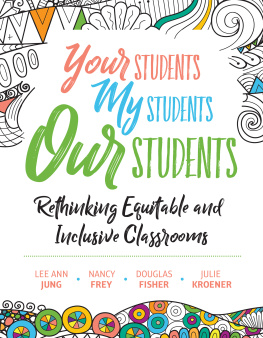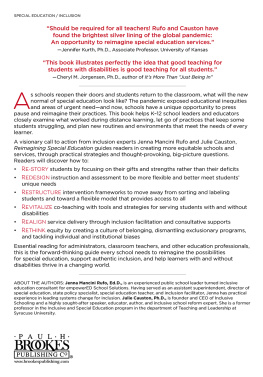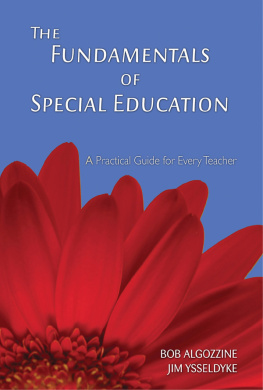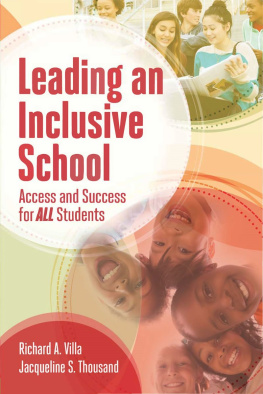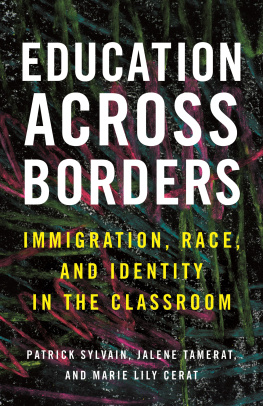Contents
Guide
Pages
Introduction
....................
"Special education class is the place they make you go to do the things you're not good at all day long."
These words of wisdom were spoken by Kevin, a middle school student with autism who spent most of his school day in a segregated classroom for students with significant disabilities. When overwhelmed, Kevin sometimes exhibited behaviors like hand flapping and rocking. He presented as a child with low communication skills, but he actually had a lot to say.
One day, when Kevin and his older brother were waiting on a corner after school, his brother was struck by gunfire, sustaining relatively minor injuries. However, there is nothing "minor" about getting shot, and the incident left the entire family traumatized. Kevin's parents wanted to move their children to another school within the district, away from the scene of the incident. But Kevin's disability was a sticking point. His mom and dad were distressed by the regression their son had experienced in the wake of his brother's shooting, and they wanted to ensure he had the best opportunities possible. Would it be better for him to stay where he was, with no disruption of service? What other options were available to him in other district schools?
Seeking answers, Kevin's parents attended workshops sponsored by the state parent training and resource center. There, they learned about a new possibility for Kevin: that he might be educated in a general education classroom. As luck would have it, the district was piloting schoolwide inclusive education practices at one middle school and one high school as part of a research study. The boys transferred to these schools. Kevin left his traditional "special education" behind, and this change transformed his life.
Kevin no longer spent his days compelled to do things he wasn't good at all day long. Yes, he required a bit of support in general education courses, but the study project plan spelled out systems for responding to the academic, behavioral, and social needs of all enrolled students. For example, when Kevin's individualized education program (IEP) team noticed that he did not participate in any extracurricular activities, they created goals for him that included attending a dance and a football game and joining an after-school club. Kevin later remarked, "When did the school teach everyone else to go to these things? How come I never learned to make friends?"
Kevin thrived in his new environment. During the summer before his junior year in high school, he earned an enviable amount of money debugging software for a local tech firm. After graduating from high school with honors, he earned an undergraduate degree in engineering and went on to work for a company thatlike Microsoft, JPMorgan Chase, and Walgreensprioritizes hiring people with autism. As enterprise application software company SAP's Silvio Bessa has noted, corporations recruit people with autism because they need the "analytic mindset" that allows them to collectively "think outside of the common boundaries" (SAP, 2013).
Today, Kevin proudly identifies himself as a person with autism and says that he "works well with NTs" (neurotypicals, a neologism for people without autism) and appreciates "what they have to offer, too." His inclusive workplace is an extension of the inclusive schooling he was first introduced to in middle school. The world experiences Kevin as a fully integrated member of society. He pays taxes, gets stuck in traffic jams, laments the losses suffered by his favorite sports team, and wishes his romantic life were better. In other words, Kevin is pretty much like everyone else. Yet he is also himself. He has autism, engages in some repetitive behaviors when he is feeling stressed, and sometimes struggles with communicating with colleagues in the workplace. The difference is that he is in a professional community that seeks to understand his differences while never overlooking the human condition that binds us all together.
Where We Are and Where Our Schools Aren't (Yet)
Globalization has flattened our world, and it's also supported greater accessibility to information and services. As one simple example, look at the accessibility features available on your smartphone. You can change the font size and alter colors to make the contrast sharper and therefore easier to read. There is voice recognition software that allows you to text and search without typing out words. Voicemail messages can be read through transcription. These and other innovations reflect the sensibility that "design is a way in which we can uphold a person's dignity and human rights" (Burke, 2017). They grew from the intersection of people with and without disabilities participating together in the social and physical world.
And yet school remains a place where these intersections are systematically minimized. This is the result of 200 years of viewing disability through a medical model that catalogs impairment rather than considers disability as a social construct that is shaped by policy, theory, and ethics. It's impossible to untangle disability from race, culture, and economics, and equity cannot be realized if some members of societyand members of school communitiesare marginalized and segregated. As a retired superintendent who oversaw the shift to inclusive education practices in his school district would remind his principals, "Show me your master schedule, and I'll tell you what your values are." Who within a building has and does not have access to "regular classes" is often a reflection of who and what matters to the educators who work there.
If students with disabilities and their peers without disabilities are to achieve at higher levels, increase the satisfaction they experience in life, and contribute as members of the community, the education system needs to changeand this will be no easy task. It requires undoing the marginalization of people with disabilities that dates back centuries and changing the expectations for students with disabilities. Yet we must try. The current system is not working for many students, and that's a problem we cannot ignore.
Understanding the Human Experience
Disability is part of the human experience. Once viewed as a static binary construct (disabled/not disabled), disability is now understood as a dimension of a person's identity, alongside race, ethnicity, language, gender, sexual orientation, and experience. It is the intersection of these "identity influences" that make each of us who we are. To segregate students according to a single identity influencedisabilityis to sentence them to a "literal disenfranchisement" that marginalizes and threatens their identify as citizens of the world (Kliewer, Biklen, & Kasa-Hendrickson, 2006, p. 186).
Further, the practice of setting up separate classrooms and schools for the education of students with disabilities also limits the experiences of students without disabilities. Consider that about 10 percent of the student population has a disability. This means an equal percentage of families10 percenthave the experience of either rearing or growing up with a child who has a disability. What does that mean for the 90 percent of students and familiesthe future employers, co-workers, landlords, neighbors, medical professionals, law enforcement officers, teachers, and parentswho may not have opportunities to spend time around people with a disability and get to know them as individuals with personalities, quirks, challenges, and successes? It's not an overstatement to say that society would be changed for the better if every school child had the chance to know and learn alongside people with disabilities and see them as peers. It's not about pity; it's about the recognition of fundamental rights and human dignity.

